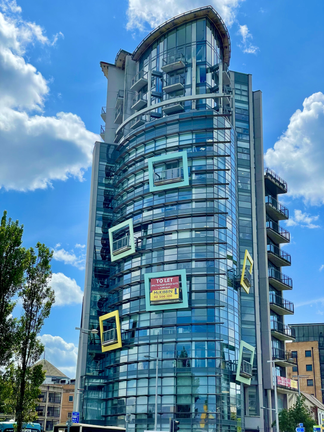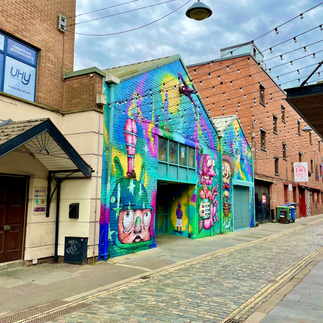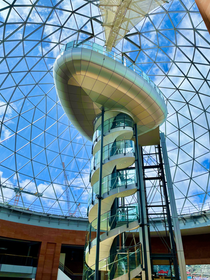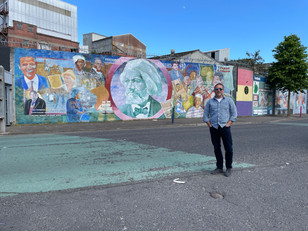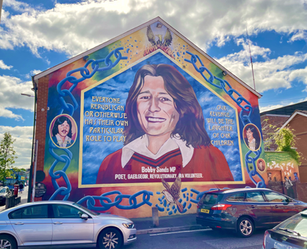Booming Belfast!
I have an unexpected opportunity to take a short city break to Belfast recently and am really happy about it. I didn’t know much about the city and, since this was unexpected, did not do much pre-planning so I was really pleasantly surprised by the capital of Northern Ireland. My visit was very short, about 30 hours in all, but in that time I had the opportunity to see much of the city center, the famous Titanic Belfast, and learn a lot more about its history.
Photos of the Irish countryside from the train and around the harbor.
Belfast is a city of about 350,000 and is the capital of Norther Ireland which is part of the United Kingdom. For most of its history, it was a small and fairly unimportant town. Scottish Presbyterians settled in the city in the 1600’s and significantly increased the manufacturing and trading of linen, briefly becoming the biggest producer of linen in the world and earning it the nickname “Linenopolis”. By the late 19th century, it was a major port and shipbuilding center, the most famous ship built here being the Titanic. Industrialization brought continued conflict between the ruling Protestants and the more rural Catholic populations who were moving to the city for increased economic opportunity. When the Republic of Ireland seceded from the United Kingdom in 1921, six northern counties became Northern Ireland and remained in the UK, with Belfast as its capital. Sectarian tensions and violence continued between the Catholics and Protestants, primarily based on power and restrictions on representation and inclusion, reaching their height during the period known as The Troubles, lasting from the late 1960’s to 1998. Belfast is still a bustling port city, the second largest city on the island of Ireland, and an interesting tourist destination.
Murals and public art throughout the city center.
I was visiting a friend in Dublin when this short trip to Belfast came up. Getting there was very easy on the train, I was able to book everything on my iPhone using the Irish Rail website. Though they are two separate countries, there remains an “open border” between them and travel was seamless with no passport or other entry requirements at all. I left from Dublin’s Connolly train station at 11:20 am and was in Belfast by 1:30 pm. I’d booked First Class tickets on the way up so it was an easy, pleasant journey. I had also booked one night at the AC Hotel (part of the Marriott chain, which I prefer), which was conveniently located on Donegall Quay and on the Belfast Harbor. The hotel, which is very modern and well designed, is within easy access to Titanic Belfast (a major tourist attraction) and the city center. I used an ATM at the (dreadful) Belfast Lanyon train station upon arrival to get some British Pounds and a quick taxi ride had me off to the hotel.
More public art in Belfast.
I had pre-booked a 3:00 pm entry time at the Titanic Belfast museum, which is a gigantic attraction in the city, so I quickly started on the 15-minute walk from the AC Hotel to the museum. Along the way were lots of great public art and photo opportunities, and the Titanic Quarter definitely appears to be an exciting up and coming living and entertainment district. There were many apartments/condos already built as well as entertain venues (a bowling alley) and dining opportunities and it looked like many more were on the way. The Quarter is also close to the working shipyards and the iconic Harland & Wolff shipyard cranes “Samson and Goliath”. The Titanic Belfast (they do not use the term museum in the official name) is huge, beautifully clad in aluminum panels, and is intended to evoke the size and place of the ship itself, some locals calling it the “Iceberg”, which it also resembles. The massive museum features interactive displays about the history of Belfast and its rise as a shipbuilding center, the construction of the Titanic, the sinking and the aftermath. I’d say the exhibits are primarily focused on the ship itself, it’s construction and operation, and less so on the sinking. What’s really intriguing is that the museum is on the site where the ship was actually build and you can see an outline of its dry dock as well as a existent one containing the actual tender used by the Titanic. If you are into ships, engineering, or maritime history, (and the Titanic of course), you’ll love this museum.
Scroll using the arrows on the photos to see a number of images from Titanic Belfast.
After the museum, I walked into the town center and started to explore the Cathedral Quarter. This part of Belfast (very close to my hotel) is centered near the St. Anne’s Cathedral and was the historical merchant center for the linen and shipbuilding trades. After years of neglect, it’s been undergoing a recent transformation into a thriving culture, dining, and entertainment area. Many of the city’s popular restaurants and bars are located here as well as lots of older buildings of architectural interest. Queen’s Square with its imposing Albert Memorial Clock served as my entrance to the Quarter and after a brief walk around, I headed to the Merchant Hotel for a drink. Built in 1857 as the home of the Ulster Bank, this gorgeous, five-star hotel is one of the top hotels in the city due to its central location and luxurious setting. I am a big fan of fancy hotel cocktail bars and apparently so are a lot of other people because this one was packed in the late afternoon. The cocktail menu was very extensive, like pages and pages of options (43 to be exact), and I landed on a Norse Reviver. This potent drink, fashioned after a Corpse Reviver, contained birch eau de vie, vodka, gin, kummel (a caraway liquor) and cane sugar syrup. It was just what the doctor ordered! I was smart enough to limit myself to one so that I would not need to be revived myself.
The amazing Merchant Hotel.
Fully fortified, my exploration of Belfast continued with walks through across the river Lagan, around Victoria Square, College Avenue and around the vast Belfast City Hall. The city is full of public art, loads of street murals, and numerous interesting shops and buildings. While I was enjoying my Norse Reviver, I googled dining options and learned that Belfast is also quite the foodie town. Two very top-rated restaurants (one Michelin star each), which I was unable to get into as they were booked solid, are Ox and the Muddler’s Club. There seemed to be many other great options to choose from but I was so happy I landed on Coco, in the Linen Quarter right neat the City Hall. Coco was very well decorated with lively, somewhat fantastical, artwork on every wall and I was lucky to grab a window table so I could enjoy the street-scene too. I had the best meal that I’ve had in a very long time – starting with lobster, scallop, and shrimp ravioli as an appetizer, seabass with crab and tomato/basil salad, and a lemon, almond polenta cake with fresh strawberries and pistachio ice cream. It was heavenly. After dinner, totally stuffed and pretty wiped out, I walked back to the hotel to call it a night.
Belfast City Hall and the delicious restaurant Coco.
The next day, my train was scheduled to depart Belfast at about 6 pm so I had almost a full day to see the city. After a hearty breakfast at the AC Hotel, I headed for the St. George’s Market. This was a Friday and the city has a history of having a Friday market that dates back to at least 1604. The current building, a beautiful red-bricked Victorian, was built about 130 years ago and now is open on Friday, Saturday and Sunday only. Its Friday market is more focused on seafood and a wide variety of handicrafts, with a few vendors selling food to take home or eat there. I was able to pick up a few souvenirs, particularly some Christmas ornaments, which I like to collect everywhere I travel for my memorable travel-themed tree. I continued around the city center using an app called Street Art which shows you the locations of urban artwork in various cities. It had pretty good coverage of Belfast and I was able to catch some very interesting murals. I also checked our a few shops, including their city center mall, Victoria Square.
Friday Market at Saint George's
I had an easy lunch and beers at a fun pub called The Dirty Onion which shared a location with a chicken-focused restaurant called Yardbird. The building itself is one of, if not the, oldest building in Belfast, dating back to 1680. Located in the Cathedral Quarter, the building has housed a number of businesses in its 340 years – a grocer, fishmonger, cement merchant, tea merchant, whisky warehouse, and chemist among other things. I had some wings and sweet potato fries (a weird and very American meal) with some great Norther Irish beers (Maggie’s Leap IPA). There were loads of people, of all varieties, in the courtyard where I was seated, it was a beautiful day, and I was so happy to be traveling again and experiencing different cultures and doing interesting things. While not fancy by any means, it was a really enjoyable hour.
More scenes from around town in city center.
My last activity for the short trip was a Black Cab tour of the more suburban areas of Belfast and the areas where most of the conflicts between the Catholic and Protestants flared up. Many companies offer these tours and my hotel easily arranged one for me. The plan was for the cabbie/tour guide to then take me to the train station for my return to Dublin after the roughly 1 ½ hour tour. My cabbie, Sean, picked me up at the hotel and off we went. The tour started at the Crumlin Road Jail and Courthouse. Neither are still in operation, the jail is now a tourist attraction and houses a conference facility, the courthouse is vacant and pending development plans. These are famous for the tunnel that runs under the road where prisoners were taken from the courthouse directly to the prison after their sentencing. The courthouse and jail were very active during The Troubles with many republicans (Catholics) tried and imprisoned there. There were daring escapes and in 1991, during the last stages of The Troubles, the Loyalist wing (people loyal to the British Crown, primarily Protestants) was bombed by the Irish Republican Army, killing two prisoners. Sean, my guide, served time in the prison at one point, having the tattoos to prove it. He didn’t reveal the reason but said it wasn’t for killing any American tourists!
Sean, me, the Black Cab and a Peace Wall, and the Crumlin Road Jail
The next stops included a number of neighborhoods with huge murals on the homes and community walls. I didn’t know much about the people or events being memorialized in this public art, but there were dozens of places where certain people, battles, or other events were honored. The residents of the homes and the neighbors maintain these murals and tributes. One interesting mural was in remembrance of the Battle of the Boyne, honored just a few days ago on July 12th, which was fought in 1690 in now what is the Republic of Ireland. The battle occurred between the forces of King James II and those of King William and Queen Mary. James’ forces lost the battle and this ultimately helped pave the way for continued Protestant supremacy on the Irish Island. The Battle is still honored today with huge bonfires and Sean was able to show me places where wood was already being gathered for them.
Murals and a bonfire in the waiting to celebrate Battle of the Boyne
One of the most interesting parts of the tour was seeing and understanding more about the “Peace Walls” which bisect many Belfast neighborhoods. The walls were started as temporary measures in 1969 to separate Republicans/Catholics from Loyalists/Protestants and prevent sectarian violence from continuing to rock the city. They were so effective at keeping people part, they eventually became permanent and there are more than 100 of them today, covering many miles of the city. Many of the walls also have gates across certain streets so that cars and people can pass through, but these are mostly then locked at night, effectively preventing people from moving from one neighborhood to another. I couldn’t believe this was still the case in 2021. Sean and I talked to a woman who lived right near where we had parked and asked her what she thought of them. She said that she wished they would go away (they are really ugly) but that it was just part of life. She said she assumed that the folks on the other side of the wall (Catholics) were nice enough but she really didn’t know any. It was clear that this distrust of the others was ingrained in her and she did not have much passion around changing the circumstances. I suspect that’s the case on both sides which is why the walls remain. There do appear to be some efforts to have the walls removed but it seems that it will be a slow process, if ever, as there is not much energy behind it.
The "Peace" Walls of Belfast
We drove through the hotbed areas of Loyalist Shankill Road and Republican Falls Road where many of the most violent actions occurred during these periods of conflict. As we wrapped up our tour, one final site was the International Wall which included murals dedicated to many areas of conflict and strife all over the world, including Cuba, Palestine, and even the US. There was also a huge mural devoted to Bobby Sands who famously staged, and died from, a hunger strike in prison to demand better treatment for Republican prisoners. He’s a hero to many in Northern Ireland.
The International Wall and more murals, including to Bobby Sands
After the tour, I had plenty of time to spare before my train and Sean suggested a pub very close to the train station. The pub was called Ronnie Drews Bar and Lounge and was about as local as you could get. Old wooden tables, booths, and a long bar with people hanging out who looked very local and very much like regulars. It was a fantastic place to plop down, drink a beer, and reflect on my trip. After a spell I walked over to the train station (basically a holding pen) to catch my train back to Dublin. Belfast was very enjoyable for a short break, a walkable city, with more than enough to do to keep me pretty busy in my day and a half. There were certainly many other things that I did not get to see and would have liked to (Ulster Museum, Botanical Gardens) and lots of good restaurants and bars to visit. It was a real surprise and I’d happily go back again.



